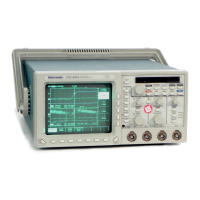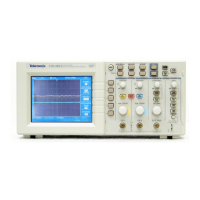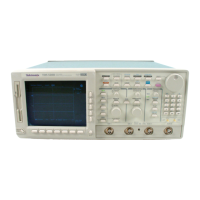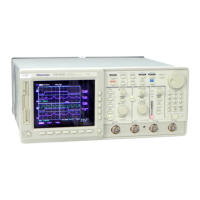TDS 420A, TDS 430A, TDS 460A & TDS 510A User Manual
3–83
Probe Cal (TDS 510A Only)
To optimize the oscilloscope capability to make accurate measurements using
particular channel and probe, execute Probe Cal on a channel with its probe
installed.
Run a Probe Cal anytime you wish to ensure that the measurements you make
are made with the most accuracy possible. You should also run a Probe Cal if
you have changed to a different probe since the last Probe Cal was performed.
Probe Cal Versus Probe Type
Some types of probes can be gain compensated, some can be offset compensated,
and some can be compensated for both. Some probes cannot be compensated.
If your probe has an attenuation factor of greater than 20X, it cannot be
compensated.
The digitizing oscilloscope cannot compensate probes whose gain and/or offset
errors are too great (2% gain and/or 50 mV offset). If these errors are not
within specification, have your probe checked by service personnel.
NOTE. Probe Cal is not recommended with the P6139A passive probe. This
probe typically has little gain and offset error, and therefore, the improvement in
performance after a Probe Cal is not worth the time needed to do the Probe Cal.
Probe Cal makes significant performance improvements when performed with
active probes or older passive probes.
Operation
If you are installing an active probe, such as the P6243, there are no prerequisites
to performing this procedure. Start at step 1.
If you are compensating for a passive probe with this procedure you must first
compensate the low frequency response of the probe. First, do steps 1 and 2
below, and then perform the instructions found under Probe Compensation on
page 3–89. Then continue with step 3 of this procedure.
1. Install the probe on the input channel.
2. Power on the digitizing oscilloscope and allow a 20 minute warm-up before
doing this procedure.

